Keywords: ASTM D5992, ISO 4664, Dynamic Mechanical Analysis (DMA), Payne Effect, Glass Transition, Wet Traction, Rolling Resistance
EF036
Abstract
Dynamic mechanical analysis (DMA) can be used to measure the viscoelastic properties of rubber materials such as styrene-butadiene rubber (SBR) compounds for sustainable and environmentally friendly tires. Rubber compounds for tires utilize fillers to optimize properties such as wear, rolling resistance, and traction. In this work, SBR with linear and branched butadiene with carbon and silica fillers was investigated. Strain, frequency, temperature, and time sweeps were conducted per ASTM D5992. There was little difference found between the branched and linear compounds and the fillers made the biggest impact in measurements. It was found that the carbon filler was poorly dispersed when compared to the silica filler, resulting in a decrease in modulus with increasing dynamic strain. Silica-filled compounds also exhibited better wet traction and rolling resistance than the carbon filled compounds.
Introduction
Advances in material development have led tire manufacturers to employ new raw materials for tire tread compounds because they directly influence key performance parameters such as wear or abrasion resistance, rolling resistance, and wet traction. These parameters are carefully balanced as improvements in one area often compromises the other.1 The properties are mainly dependent on rubber matrix, filler, and their interaction with each other.2 The most widely used rubber matrices in passenger tire tread compounds are styrene-butadiene (SBR) and natural rubber (NR). Lee et al illustrated previously that the wear resistance of these matrices can be improved by the addition of butadiene rubber (BR).3
Carbon black is one of the fillers used frequently for reinforcing rubber, and its effect on dynamic mechanical properties is well established. In recent years, precipitated silica is gaining popularity as a filler due to its balanced properties of rolling resistance, wet grip, and abrasion resistance.4,5 It is also known as greener filler for tire tread rubber compounds because of its lower impact on the environment by reducing fuel consumption and CO2 emissions.6,7
In this note, viscoelastic properties of SBR mixed with linear and branched butadiene, and carbon and silica filler are systematically investigated using dynamic mechanical analysis. Flexing fatigue and heat generation of the same compounds were evaluated in a previous publication using a HighForce DMA (Model ElectroForce 3330 from TA Instruments).8 Pre-cure and processing properties were also evaluated for the same compounds previously by Heinz et al using Rubber Process Analyzer (RPA) from TA Instruments.9
Materials and Methods
Four rubber compounds were compared in this study. For each compound, rectangular samples of 10 mm width and 40 mm length were cut out of cured rubber sheets of ~2 mm thickness to accommodate a 25 mm fixture-to-fixture gauge length. The dimensions were consistent for temperature, strain, frequency, and time sweeps.
The composition of the rubber compounds is summarized in Table 1. The formulations were adjusted to obtain a similar shore hardness to get a relevant post-cure comparison. In addition to silica and carbon black, linear and branched butadiene were also varied in the styrene-butadiene matrix. Since silica exhibits poor interaction with the non-polar SBR and BR molecules, silane was added to increase its affinity to the non-polar molecules.
Dynamic mechanical analysis (DMA) was carried out on High Force DMA (Model ElectroForce 3200 with 500 N capacity). The DMA was equipped with a forced convection oven (Figure 1) having an isothermal stability of ±0.1 °C and a temperature range of -150 °C to 600 °C. The DMA tests were conducted per ASTM D5992 forced non-resonant method.
Tension film/fiber clamps were used to affix the sample inside the furnace. A thermocouple located within the forced convection oven cavity was used to take temperature measurements.
WinTest® DMA Application software was employed to produce viscoelastic measurements including complex modulus, storage modulus, and loss modulus as well as tangent delta, also known as loss factor. These results are obtained from the precise measurement of the magnitude and phase relationships between cyclic force and displacement signals as the material responds to dynamic and mean strains. Before all the tests, the furnace was held at the start temperature and conditioned for 5 minutes.
Different DMA tests conducted are summarized in Table 2.
Table 1. Summer tire tread formulations
| Compound designation | ||||
|---|---|---|---|---|
| Components | Lin-Si (phr) | Lin-C (phr) | Br-Si (phr) | Br-C (phr) |
| Styrene-Butadiene Rubber (SBR) | 96.25 | 96.25 | 96.25 | 96.25 |
| Butadiene Rubber (BR) | 30 (Linear) | 30 (Linear) | 30 (Branched) | 30 (Branched) |
| Silica | 80 | – | 80 | – |
| Carbon Black (N-234) | – | 73 | – | 73 |
| Silane (Si-266) | 5.8 | – | 5.8 | – |
| DPG-80 | 2.5 | – | 2.5 | – |
| Vulkacit CZ (CBS) | 1.6 | 1.6 | 1.6 | 1.6 |
| Perkacit | 0.2 | – | 0.2 | – |
| Sulphur | 2 | 1.4 | 2 | 1.4 |
| A/S ratio | 2.15 | 1.14 | 2.15 | 1.14 |
Table 2. DMA test plan
| DMA Test | Mode | Purpose |
|---|---|---|
| Strain Sweep | Tension | To assess Payne Effect and filler-filler interaction |
| Frequency Sweep | Tension | To estimate wet traction and rolling resistance at 0 °C and 70 °C, respectively |
| Temperature Sweep | Tension | To measure primary glass transition temperatures |
| Time Sweep | Tension | To check material’s mechanical stability and ageing characteristics |
Strain Sweep
To evaluate the Payne effect, strain sweeps (also known as amplitude sweeps) were carried out at 25 °C ambient temperature and 10 Hz. A continuously incremental dynamic strain was applied, and the mean strain was adjusted at each dynamic strain to always keep the test in tension. The sum of static and oscillatory strain was reported as total or absolute strain, which is most relevant for evaluating the effect of changing filler-filler interaction.
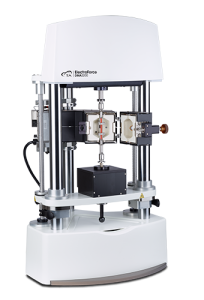
Temperature Sweep
A temperature sweep was carried out to obtain the glass transition of the rubber compounds. A dynamic strain of 0.05% was imposed on a continuously adaptive mean strain to always keep the sample in tension. A temperature range of -100 °C to 100 °C was used using liquid nitrogen. Note: The strain of 0.05% was within the materials’ linear viscoelastic range, measured using a strain sweep at -100 °C and 10 Hz. LVR was identified as the absolute or total strain where the storage or elastic modulus decreased by 10% from the maximum value (results not shown in this note).
Frequency Sweep
The frequency sweeps were carried out at 0 °C and 70 °C to obtain indication of differences in wet traction and rolling resistance. The test was conducted at 0.1% dynamic strain from 0.5 Hz – 100 Hz frequency range and the mean strain was adjusted automatically to always keep the sample in tension.
Time Sweep
The stability or mechanically aging of the rubber compounds was evaluated with a time sweep for 15 hours at 25 °C, 10 Hz, and 5% dynamic strain. Mean strain was adjusted automatically, as explained previously.
Results and Discussion
Payne Effect
Payne effect is defined as the decrease of elastic modulus with increasing dynamic strain and is typically observed in highly filled rubbers.10 It is linked to the filler-filler agglomerates formed due to inadequate mixing, which start to split at higher dynamic strains. All compounds indicated the Payne effect, albeit each to a different extent (Figure 2). Generally, carbon black-filled compounds indicated higher initial storage modulus, but they also exhibited higher Payne. This is undesirable as it leads to a reduction in the fuel economy of the tires due to the energy being expensed in breaking agglomerates. Silica-filled compounds have less initial modulus compared to carbon black-filled compounds and the extent of the Payne effect was also less. If the storage modulus is extrapolated beyond 20% cross-over strain, the storage modulus of carbon black-filled compounds is expected to reduce further. No conclusive difference between linear and branched butadiene rubber was observed.
Usually, higher tan delta points to higher hysteresis and more energy absorbed. The increase in the tan delta in carbon black-filled compounds is twice as much as in silica-filled compounds. The absorbed energy from hysteresis manifests itself in the form of temperature increase in the tire material. This was quantitively measured and reported in the heat build-up results performed previously per ASTM D623 where carbon black-filled compounds indicated twice as much increase in temperature as silica-filled compounds.8
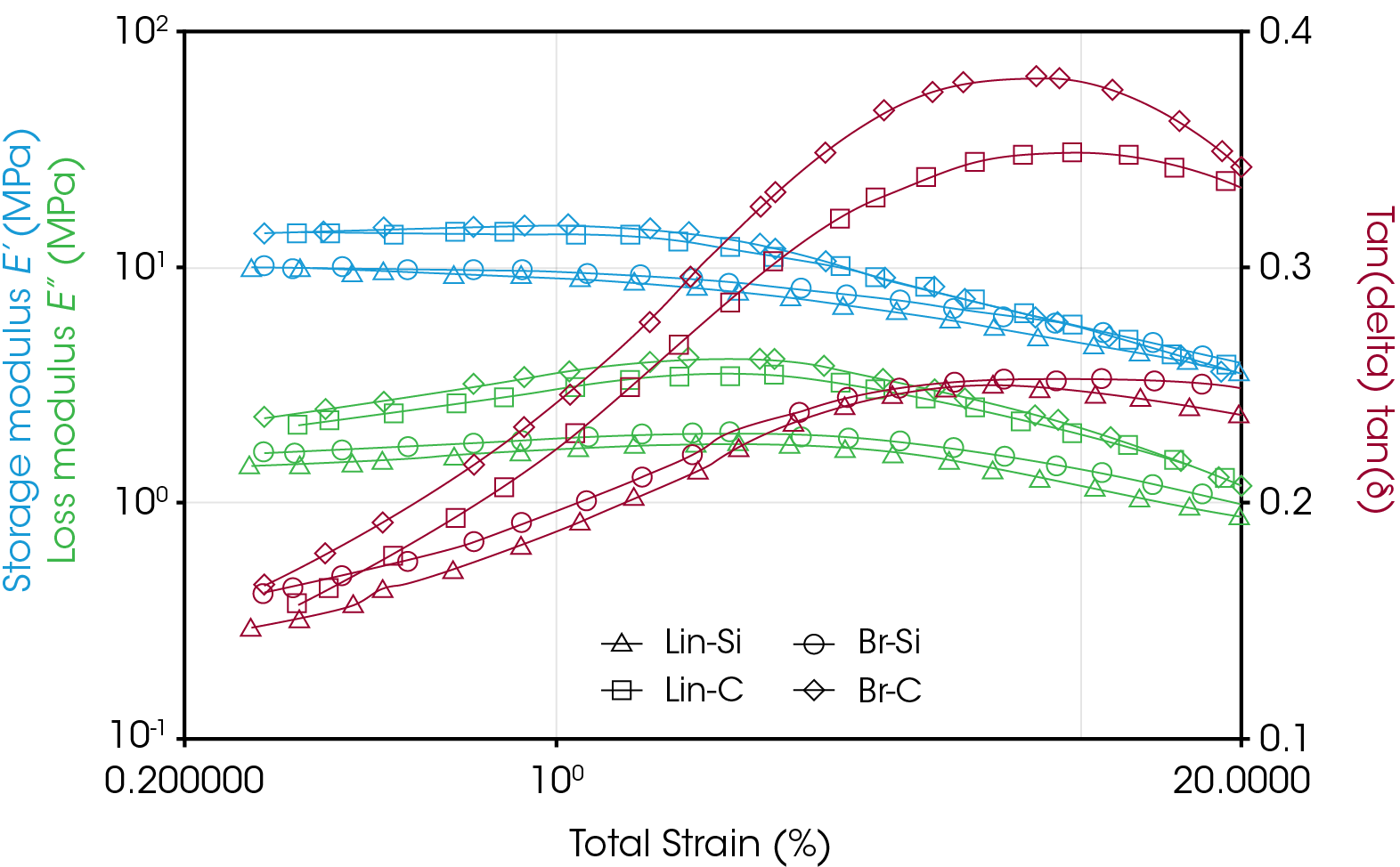
Glass Transition Temperature
Temperature sweep data shown in Figure 3 indicates glass transition temperature as the peak of the tan delta. Both compounds with carbon black gave a glass transition temperature of -28 °C whereas silica-filled compounds showed a glass transition temperature of -23 °C. A difference of 5 °C despite the same butadiene and styrene butadiene matrix cannot be explained simply because of different fillers, as glass transition is generally understood to be a property of the rubber matrix.
In addition to different tan delta peaks, the width of tan delta peaks is also different. The silica-filled compounds exhibited broader peaks as compared to the carbon black-filled compounds. It is therefore suspected that the weight distribution of molecular chains has increased in silica-filled compounds, possibly due to added silane. Another variable that could potentially affect the molecular weight distribution is the accelerator-to-sulfur ratio which was adjusted for both silica- and carbon black-filled compounds to obtain similar shore hardness. Since silica-filled compounds showed higher glass transition temperature, it is speculated that higher accelerator-to- sulfur ratio contributed towards higher concentration of sulfur cross links, which ultimately restricted long chain movement at lower temperatures. Therefore, the temperature required to enable molecular motion from glassy to rubbery state is increased.
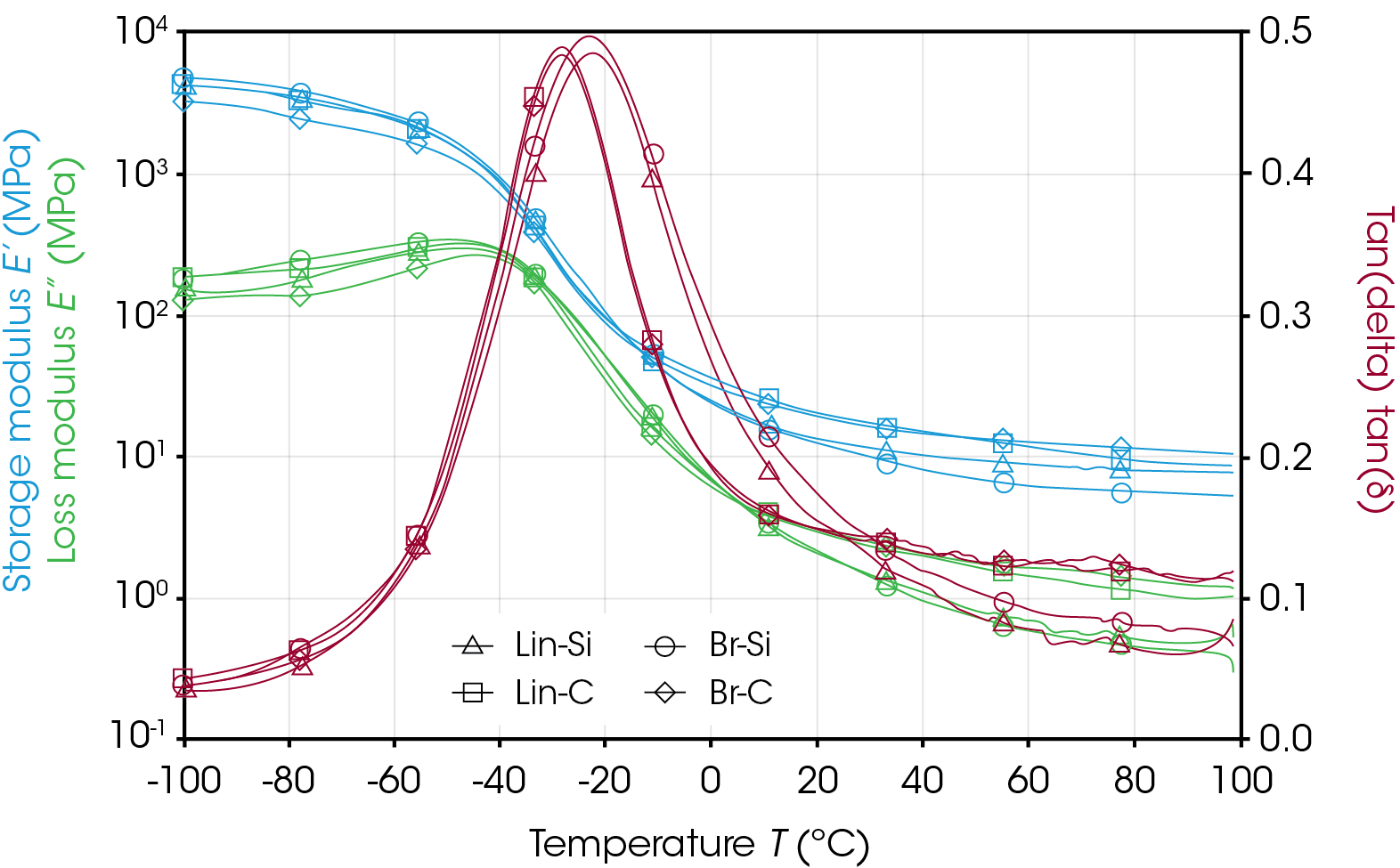
Wet Traction and Rolling Resistance
Tan delta values at 0 °C and 70 °C give insights into wet traction and rolling resistance of the tire tread compounds.11, 12 Higher tan delta is desired at lower temperature to provide enough loss deformation and therefore higher hysteresis for good gripping. Lower tan delta is desired at higher temperatures to avoid unnecessary deformation and hysteresis that would otherwise increase fuel consumption. Silica-filled compounds are not only offering higher tan delta at 0 °C but also lower tan delta at 70 °C than carbon-filled compounds as shown in Figure 3.
Wet traction was further examined by conducting a frequency sweep at 0 °C (Figure 4). With increasing frequency, storage modulus increases as expected with any elastomeric compound. It is interesting to note that tan delta increases with increasing frequency. It is useful to have higher traction at higher frequencies to provide better grip and stability to the vehicle as it travels with higher speeds. Silica-filled compounds reveal a higher tan delta compared to carbon black-filled compounds demonstrating a better wet grip at all frequencies.
Similarly, rolling resistance is also investigated by conducting a frequency sweep at 70 °C (Figure 5). Storage modulus exhibited a similar increase, but the extent of increase was less compared to the low-temperature frequency sweep. Tan delta for silica-filled compounds was lower than carbon black-filled compounds at all frequencies and independent of frequency. This indicates that the hysteresis will not increase by increasing the frequency and hence there is minimal impact to fuel consumption.
The data from frequency sweeps at 0 °C and 70 °C shows the potential of silica-filled rubber compounds not only as an alternate candidate for carbon black-filled rubber compounds but also for all-weather tires offering balanced properties during winter and summer.
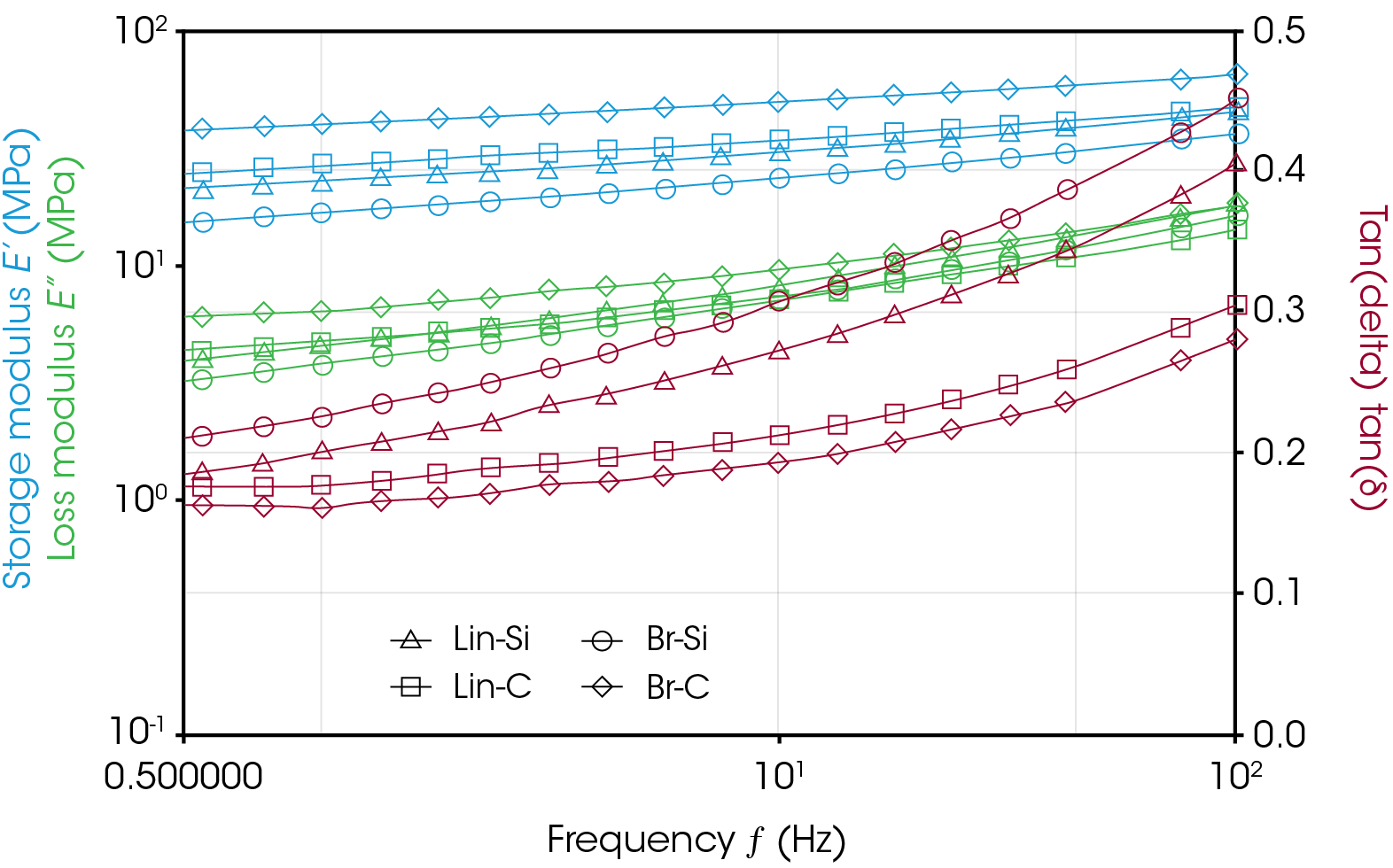
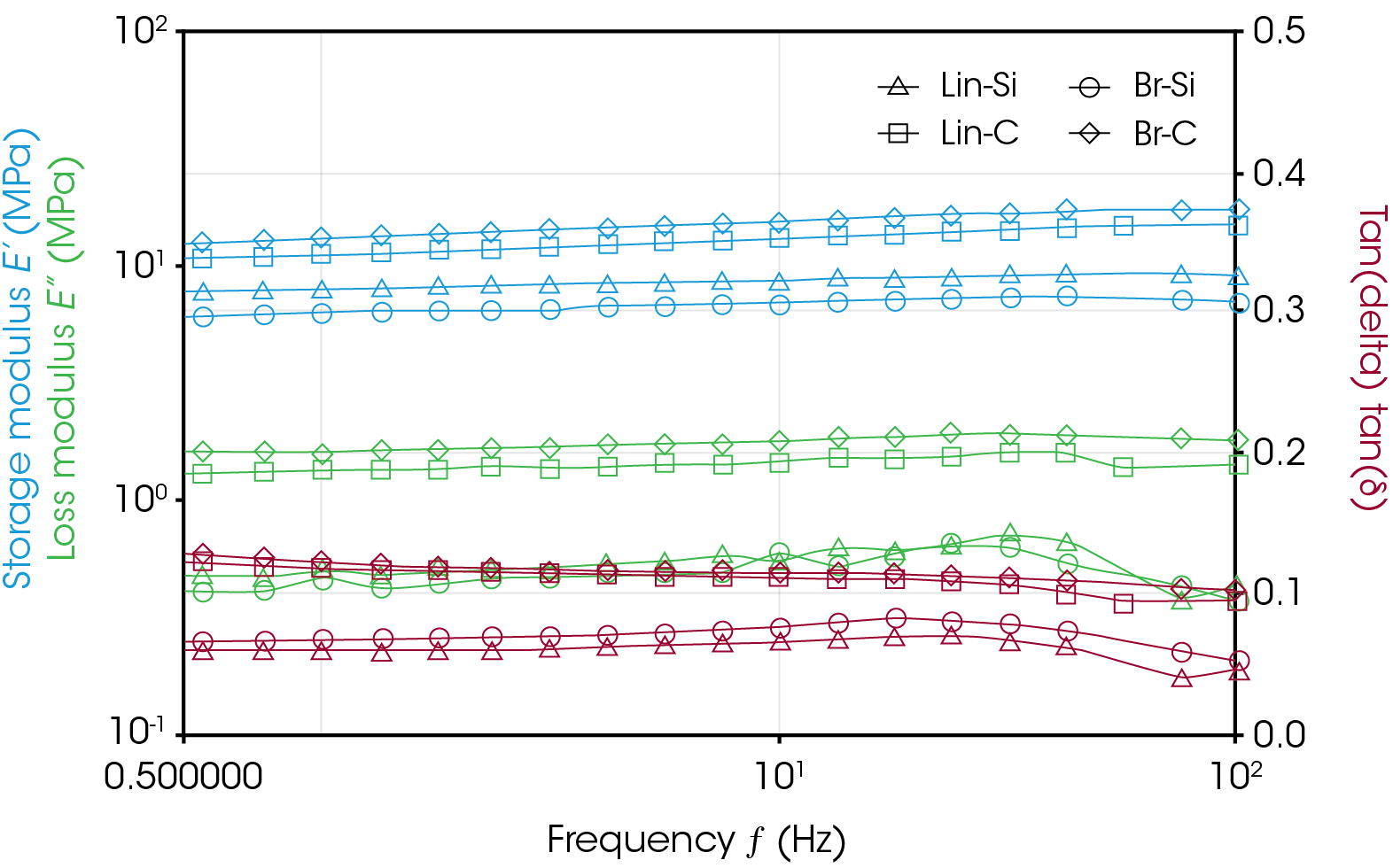
Mechanical Stability or Ageing
Time sweeps are typically employed to check the stability of polymers because they can undergo micro- and macro-structural rearrangement with time. The tire tread rubber compounds were tested for time sweeps and the resulting data is depicted in Figure 6.
A reasonable match is observed if the initial value of tan delta for each tire tread rubber compound in the time sweep (Figure 6) is compared with tan delta at 5% strain in the strain sweep data (Figure 2). Nonetheless, as the time sweep progressed, the tan delta showed a relatively sharp exponential decrease in the first two hours (120 minutes/7200 seconds). After two hours, the tan delta was stable throughout the experiment. This may be an indication of mechanically induced structural changes that are modifying the viscoelastic response of the material until the material has reached a state of viscoelastic equilibrium. Storage modulus was also reduced by more than 10% compared to the beginning of the test. Surprisingly, the difference between linear and branched butadiene became more pronounced after two hours and continued to increase. Silica and carbon-filled rubber compounds with linear butadiene rubber showed lower tan delta compared to the branched butadiene rubber. This difference was indistinguishable at the beginning and might explain why such a difference cannot be seen in the strain sweep due to the limited time of the experiment. A previously published application note investigated fatigue and heat build-up of these materials. 8
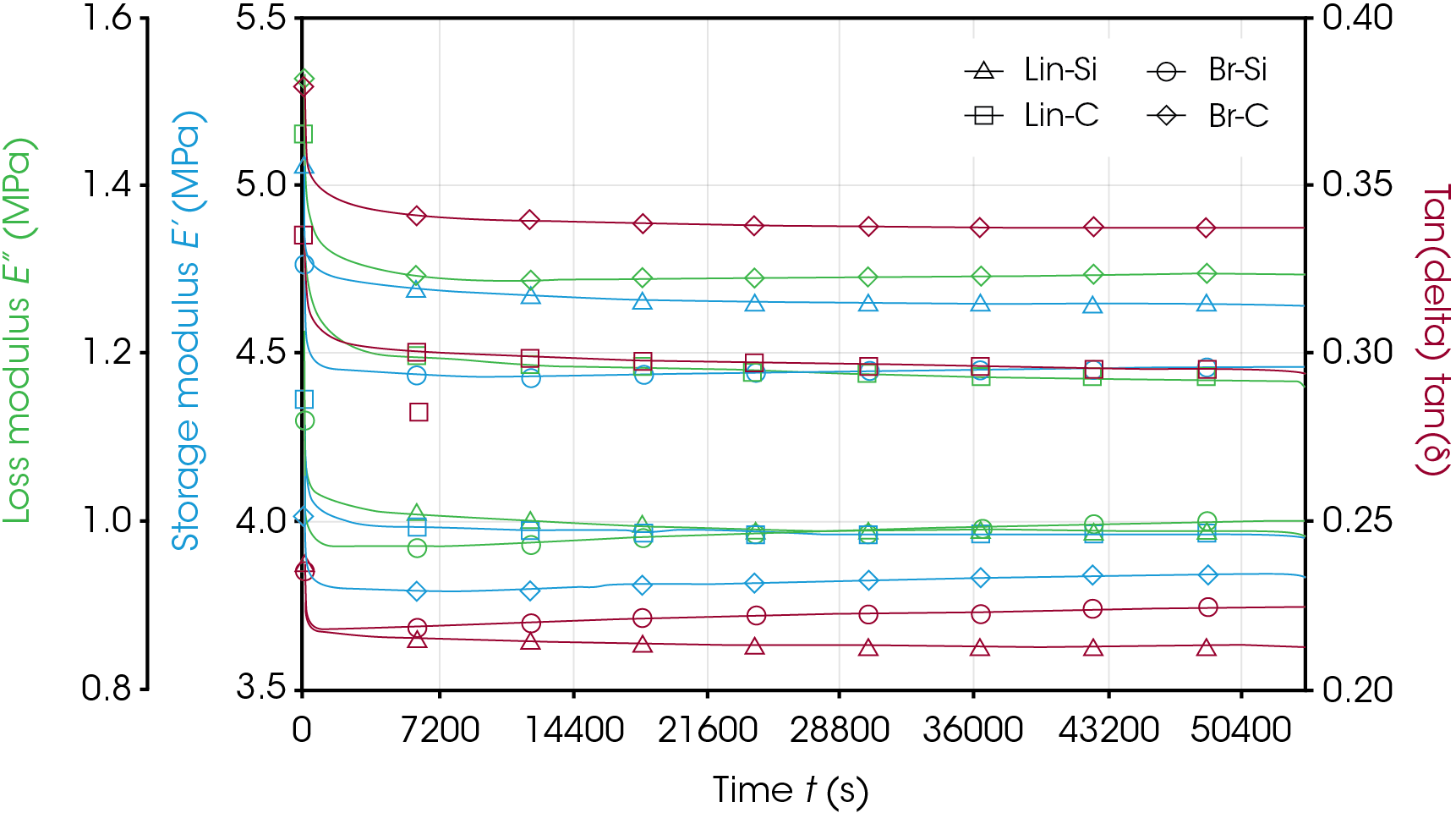
Conclusions
Viscoelastic properties of silica- and carbon black-filled styrene butadiene rubber provided significant insights into the dynamic performance. Strain sweep data indicated carbon black dispersibility in the compound was poor in comparison to silica/silane compound and led to agglomerates exhibiting Payne effect. A 5 °C difference of glass transition temperature between the two fillers and difference in peak width of tan delta likely originated from silane or the higher accelerator to sulfur ratio, which possibly contributed to a higher cross-link density. Frequency sweep at 0 °C and 70 °C showed that both the wet traction and the rolling resistance of silica-filled compounds was better than carbon black. However, no discernable difference between linear and branched architect of butadiene was seen. Time sweep data illustrated the stability of rubber compounds and was the only test that indicated measurable difference in linear versus branched butadiene in silica compounds.
Performing viscoelastic measurements to evaluate key performance parameters allows highly repeatable measurements to be performed in a lab environment. This provides for fast, efficient, and data driven compound development. These measurements can be evaluated with several methods that, when used together, can reveal important insights into how material design and its structure changes impact material performance. The viscoelastic data presented in this study signify better performance and higher sustainability of silica-filled tire tread compounds by offering improved fuel economy and reduced environmental impact.
Future Outlook
The current study measured the performance of carbon-filled and silica-filled compounds for tire tread application utilizing dynamic mechanical analysis. It will be beneficial to explore the same rubber compounds for their fatigue strength to estimate their life cycles and long-term stability at different temperatures.
References
- Terrill, E. R., Centea, M., Evans, L. R., & MacIsaac Jr, J. D.(2010). Dynamic mechanical properties of passenger and light truck tire treads. Report No. DOT HS, 811(270), 28.
- Ten Brinke, J. W., Debnath, S. C., Reuvekamp, L. A., & Noordermeer, J. W. (2003). Mechanistic aspects of the role of coupling agents in silica–rubber composites. Composites Science and Technology, 63(8), 1165-1174.
- Lee, H. G., Kim, H. S., Cho, S. T., Jung, I. T., & Cho, C. T.(2013). Characterization of solution styrene butadiene rubber (SBR) through the evaluation of static and dynamic mechanical properties and fatigue in silica-filled compound. Asian Journal of Chemistry, 25(9), 5251.
- Flanigan, C. M., Beyer, L., Klekamp, D., Rohweder, D., Stuck, B., & Terrill, E. R. (2012). Comparative study of silica, carbon black and novel fillers in tread compounds. Rubber World, 245(5), 18-31.
- Zafarmehrabian, R., Gangali, S. T., Ghoreishy, M. H. R., & Davallu, M. (2012). The effects of silica/carbon black ratio on the dynamic properties of the tread compounds in truck tires. E-journal of Chemistry, 9(3), 1102-1112.
- Lolage, M., Parida, P., Chaskar, M., Gupta, A., & Rautaray, D. (2020). Green Silica: Industrially scalable & sustainable approach towards achieving improved “nano filler–Elastomer” interaction and reinforcement in tire tread compounds. Sustainable Materials and Technologies, 26, e00232.
- Sarkar, P., & Bhowmick, A. K. (2018). Sustainable rubbers and rubber additives. Journal of Applied Polymer Science, 135(24), 45701.
- Haris, M. (2021). Evaluating Fatigue Characteristics and Heat Generation in Silica ‘Green Tire Recipe’ and Conventional Carbon Black Filled Rubber, TA Instruments, https://www. tainstruments.com/pdf/literature/EF033.pdf.
- Heinz, M., Kroll, J., & Rauschmann, T. (2017). Characterization of Summer Tire Tread Compounds by Large Amplitude Oscillating Shear (Laos). KGK-KAUTSCHUK GUMMI KUNSTSTOFFE, 70(4), 41-46.
- Hentschke, R. (2017). The Payne effect revisited. Express Polymer Letters, 11(4).
- Wang, M. J. (2008). Effect of Filler-Elastomer Interaction on Tire Tread Performance Part Ii Effects on Wet Friction of Filled Vulcanizates. KGK. Kautschuk, Gummi, Kunststoffe, 61(1-2),33- 42.
- Wang, M. J. (2007). Effect of filler-elastomer interaction on tire tread performance Part I Hysteresis of filled vulcanizates. KGK. Kautschuk, Gummi, Kunststoffe, 60(9), 438-443.
Acknowledgement
This paper was written by Muhammad Haris, Applications Support Engineer at TA Instruments.
Click here to download the printable version of this application note.

